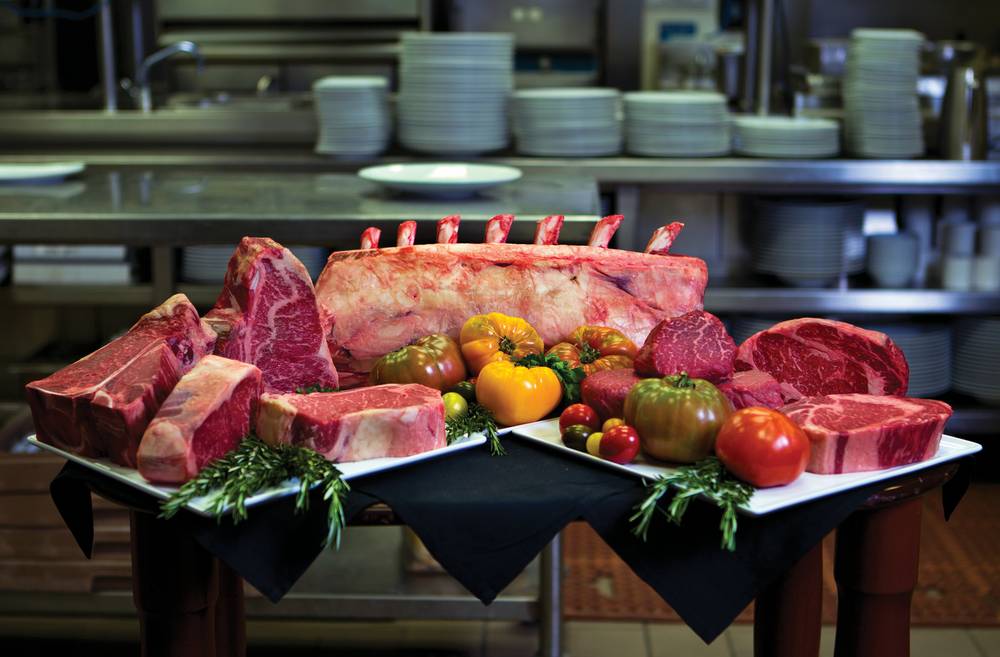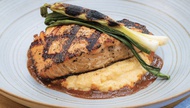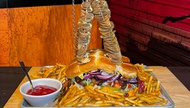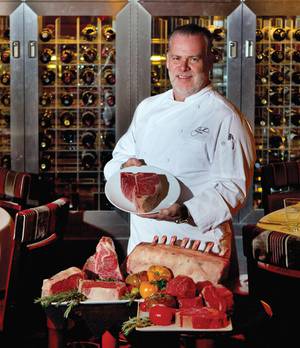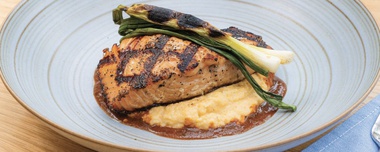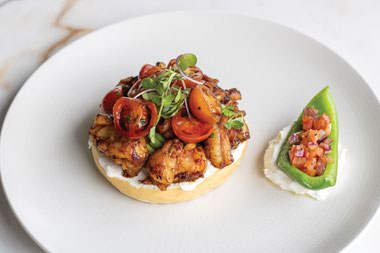The Charcoal Room’s kitchen is immaculate, all white and stainless steel, sterile to near hospital levels. Before the crew has arrived to prep for a busy Friday night, only one eye-catching splash of deep crimson stands out: a selection of steaks ready to be grilled and tasted.
Bryan Dillon, director of luxury culinary operations at Station Casinos, points at one beautiful beef jewel, a fat-marbled New York strip from 7X Beef in Colorado. “This is the only true, full-Japanese breed that is grown in the United States exactly as they do in the Kobe prefecture,” he says. “This comes shipped with the animal’s birth certificate, and it actually has the nose print of the animal. It’s truth in menu, and it’s one of those things … it’s the right way or we don’t do it.”
The Las Vegas Strip has become one of the country’s steakhouse capitals. Each casino-resort offers at least one restaurant serving the best beef money can buy. But locals know the most satisfying steak in their neighborhood is likely found at the nearest Station property.
To maintain that reputation, Dillon and his team—including Santa Fe executive chef Joe Koniski—are constantly studying beef trends, tasting and testing new products, and traveling to purveyors’ headquarters, ranches, slaughterhouses and other restaurants. “We are always checking the quality of product,” says Dillon, who’s been with Station for 15 years. “You have to keep the integrity of the program and keep your vendors honest.”
Station buys beef from all over—wherever Dillon can find the very best. “We ask for samples so much, 90 percent of the time we just buy the product, because we don’t want people to handpick our samples. The minute you start buying it, the animal changes and the product changes.”
No matter where the cow is raised, it goes through Chicago en route to Vegas. Buedel Fine Meats and Provisions handles the beef aging process for Station, which maintains strict guidelines for cut, cleanliness of trim, size and shape of each steak. It needs to have significant height on the plate to meet the Station standard, but nothing is more important than taste. “We try at least one of every steak every night at Charcoal Room,” Koniski says. “We have our own preferences, but it’s all about the guests. We tailor everything specifically to that restaurant’s guests.” The filet is still the most popular cut across the board, even if Koniski prefers the sirloin for its great texture and body.
Once Dillon and Koniski sort through this round of steaks—they’re all juicy and delicious, though you can smell, see and taste the rich difference in the dry-aged and grass-fed selections—choices will be considered for various venues. Then it’s time for the most important test. “I give steaks to [Station Casinos CEO] Frank Fertitta every week,” Dillon says. “I bring what’s eating best right now, and he makes the final decision.”
The diner may be satisfied, but the quest for the perfect steak is never-ending. Dillon implores his cooks to eat out often in order to stay on top of their game. “If you’ve never experienced the greatest steakhouse we have in our city, you need to,” he says. “How are you going to replicate that experience?
“For us, it’s not like on the Strip, where they see their guests once a year. It’s not about just coming out to eat. If our customers are plopping down $100 or more for dinner, we better make sure every part of that experience is impeccable. We make sure when they think of steak, they think of Station.”
Bonus beef tips
Grass is hot Dillon say grass-fed beef is the hottest product on the market right now, but he’s having a hard time finding suppliers to keep up with his demand. “Most of these grass-fed ranches have a human component to their [operation] where if they can’t sell you the whole cow, they won’t sell, which makes sense. There are only eight filets on one animal. That’s a 900-pound carcass and you’re only using seven pounds.” Station steakhouses serve two grass-fed cuts, a filet and a New York. If they can’t find the good stuff, they won’t buy anything else. “We’ll have the chef go out to your table and apologize, saying, ‘We know you came for this but we couldn’t find [product] with the consistency we want.’ If it’s not the world’s best, we’re not serving it.”
Put some funk on it Aging is the process in which, over days of weeks or months, microbes and enzymes break down the meat’s tissues, rendering it more tender and giving it a more full-bodied flavor, sometimes even nutty or cheesy. Station’s most intense aging program involves 21 to 28 days of wet-aging—where the meat is wrapped up and does not interact with oxygen—before another 35 days of dry-aging, which allows the meat to lose water and gain more true beefiness.
What’s your temp? “When you eat a prime steak, to truly get the full experience you want to eat it at medium rare to just medium,” Dillon says. “If you go rare on one of these really fat-marbled steaks, it’s going to turn out a little tougher if you haven’t heated it enough to melt those particles of fat and get that texture and body you’re looking for.” Station steakhouses cook their steaks one temp under what you order, because the meat continues to cook as it’s being rested and plated. When it gets to your table, it’ll be just right.
Start in the center “Always cut from the middle and work your way out. That will give you consistency from end to end,” Dillon says. Remember, it’s still cooking. If you take your first bite from the end, by the time you eat to the other side, it might not be as moist.
Japan via Colorado That 7X Kobe we tasted at Charcoal Room? It’s amazing, it costs Dillon more than $100 per pound, and it’s going on the menu at Red Rock Resort’s T-bones restaurant in two different cuts.
